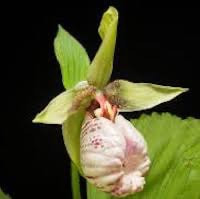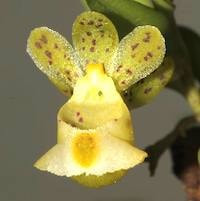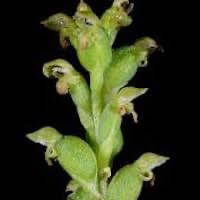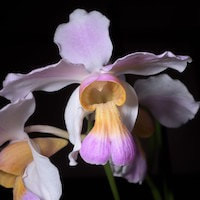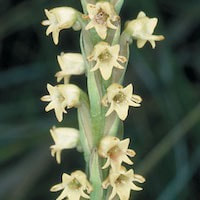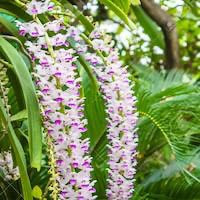WOR2- Women's Oriental 2 - I bay leaf in you!
|
Native Singaporean Orchid notes: Bulbophyllum Macranthum
Peristylus affinis, also known as Xiaohuakuorui Lan in Chinese, is an orchid valued for its unique fragrance and medicinal benefits in traditional Chinese medicine. It is recognized for its ability to clear heat and detoxify the body, making it useful in treating nephritis, a kidney inflammation condition. This orchid is also employed to relieve symptoms of weak kidneys such as fatigue and frequent urination, and it provides relief from lower back pain. While traditional uses are well-documented, further scientific research is needed to fully validate its effectiveness and safety.
|
Therapeutic Orchid notes:
|
Cypripedium japonicum Thunb.
Cypripedium japonicum Thunb., known as Shanmaishao Lan in Chinese, is a medicinal orchid highly esteemed in traditional Chinese medicine for its diverse therapeutic properties. It is valued for dispelling wind-related ailments and detoxifying the body, enhancing overall health. The herb is believed to regulate qi flow, promoting energy balance and vitality. It supports blood circulation, benefiting cardiovascular health, and provides pain relief for injuries and conditions like low backache. Used in treating tertian malaria, it's consumed before symptoms, and for pruritic rash, its decoction soothes skin. It's also applied to snake bites for symptom management. |
|
Gastrochilus formosanus (Hayata) Hayata
Gastrochilus formosanus (Hayata) Hayata, also known as Taiwansong Lan, Taiwannanchun Lan, Taiwan Pengju Lan, and centipede orchid in Chinese, is a small epiphytic orchid prized for its medicinal benefits. Found in Taiwan, Fujian, Hubei, and Shaanxi, it features a distinctive long, flat stem. In traditional herbal medicine, the entire plant is used for its antipyretic properties, helping to reduce fever and lower body temperature. It is also valued for its detoxifying effects, aiding in the elimination of toxins from the body, promoting overall purification and health. |
|
Microtis unifolia (Forst.) Rchb. f.Syn. Microtis formosana Schltr. ex Masam
Microtis unifolia (Forst.) Rchb. f., also known as Microtis formosana Schltr. ex Masam, is a versatile orchid species with several traditional Chinese names such as Jiuye Lan (garlic leaf orchid), Congye Lan (onion leaf orchid), and medicinal names like Shuangshencao (two-kidney grass), Zhuitaocao (drop peach grass), Yigencong (single piece onion grass), and Chengtuocao (weight grass). In Maori culture, it is referred to as Maikaika. Harvested in April and May, its medicinal parts are washed, dried, and used in traditional Chinese medicine to benefit the spleen and kidneys. It treats conditions such as weak spleen, loss of appetite, weak kidneys, backache, and hernia pain by aiding digestion, relieving discomfort, and supporting overall health. |
|
Papilionanthe teres (Roxb.) Lindl. Syn Vanda teres Roxb.
Papilionanthe teres (Roxb.) Lindl., formerly Vanda teres, is a versatile orchid known by various names across cultures: Banghua Lan (stick flower orchid), Jianyewandai Lan (sharp-leaved ten-thousand-generation/Vanda orchid), Bangyewandai Lan (terete leaf Vanda orchid), Bangyeyu Lan (terete leaf jade orchid), Fengdie lan in Chinese; Chaitek Lei in Manipuri and cylindrical Vanda in India; Anggerik pensil in Indonesia; and Potloodorchidee in Belgian. In Nepal, it’s called Harjor and Thurjo in Nepali, and Harjor among the Gurung people. Famous as Singapore's national flower parent, it thrives in various Asian regions, including Myanmar, Yunnan, Laos, Vietnam, and Thailand, up to 600 meters altitude. Its stems contain eucomic acid and vandateroside II, with potential antioxidant benefits and relevance in anti-aging cosmetics. It's also valued in traditional medicine across Asia for improving blood flow, reducing swelling, and treating ailments like dislocated bones and fever, showcasing its cultural and medicinal significance. |
|
Peristylus affinis (D.Don) Seidenf. syn. Peristylus sampsonii Hance
Peristylus affinis (D.Don) Seidenf., also known as Peristylus sampsonii Hance, is a charming orchid with the Chinese name Xiaohuakuorui Lan, meaning "small flower broad pistil orchid." Blooming from June to September, it exudes a captivating scent. In traditional Chinese medicine, the whole plant is valued for its heat-clearing and detoxifying properties, used to treat conditions like nephritis, weak kidneys, and backache. Its aromatic qualities are believed to enhance its therapeutic effects, reflecting its importance in promoting health and treating ailments in traditional Chinese medicinal practices. |
|
Rhynchostylis retusa (L.) Blume
Rhynchostylis retusa, commonly known as Fox Tail Orchid, is a versatile orchid species celebrated across different regions with various names like Zuanhui Lan in Chinese, Dronpadi Mala in Hindi, and Alyaret in Thai. It thrives in dry deciduous and evergreen forests spanning from Sri Lanka to the Philippines, including India, Myanmar, Thailand, and Malaysia. This resilient epiphytic plant requires dry periods to bloom and has been studied for its chemical composition, revealing traces of alkaloids. In traditional medicine, it serves multiple purposes: in India, it's used for rheumatism and diarrhea remedies; in Arunachal Pradesh, its roots, known as Rasna, address asthma and menstrual disorders. The Fox Tail Orchid's widespread popularity stems from its medicinal benefits and clusters of beautiful flowers. |
Other scent note
Top Notes of Nutmeg, Saffron; Middle of White Pepper, saffron, Amber, Vanilla, leather, Ambrette, Cardamom
Scentopia Library Reference ingredient
Arum Lily - Check details at Scentopia's scent library
Download the guided mediation that works best with this Orchid fragrance oil
| women_oriental_essential_oil_orchi_00002.mp3 | |
| File Size: | 57238 kb |
| File Type: | mp3 |

